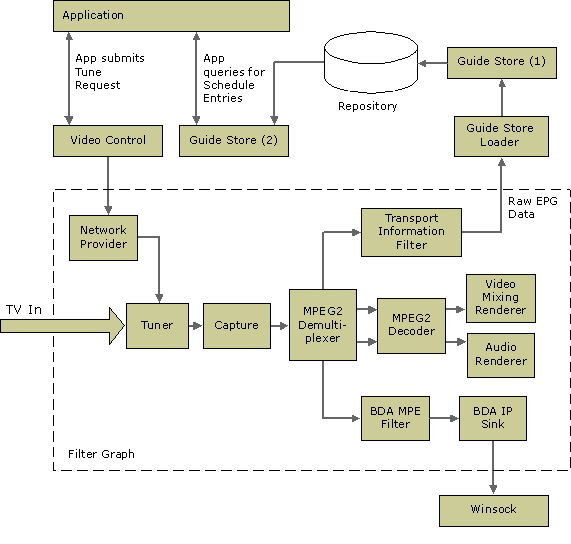
| Microsoft DirectX 8.1 (C++) |
This topic applies to Windows XP Home Edition and Windows XP Professional only.
The Guide Store is a persistent storage mechanism, or database, for Electronic Program Guide (EPG) information.
The purpose of the Guide Store is to give client applications easy access to EPG information and associated tuning information. Typically, a client application uses the Guide Store in conjunction with the Video Control to display a program schedule and enable the user to tune to a single program or set up a viewing schedule. The client application does not need to construct any tune requests; it only needs to create an instance of the Guide Store and the Video Control.
The Guide Store repository typically contains EPG information from an in-band data stream that is part of a digital television broadcast signal. The repository is updated by the Guide Store Loader, which in this version of Microsoft® Windows® XP Home Edition and Windows XP Professional, must be implemented by third parties. Applications generally do not need to manipulate the contents of the repository, although they can do so in order to add application-specific information about programs or other objects.
The general flow of information is shown in the following diagram.

This data flow diagram depicts the Guide Store repository as a central resource for client applications. When a filter graph is built, the Transport Information Filter automatically starts up the Guide Store Loader and passes EPG information to it. (In this version of Windows XP Home Edition and Windows XP Professional, third parties must implement their own loader using the Transport Information Interfaces.) The loader formats and stores the information in the repository using an instance of the Guide Store. The client application creates its own separate instance of the Guide Store and uses it to retrieve the information.
The Guide Store Loader is responsible for adding new data to the repository. It is the responsibility of the client application to remove data that is no longer of interest to it, such as schedule entries that fall in the past.
The Guide Store repository is updated and read only by using interfaces of the Guide Store component. Even if the client application is a Guide Store loader, all its interactions with the repository must be made using the provided interfaces.
The repository contains tune requests in the form of serialized COM objects. The method to retrieve the tune request for a service object re-creates the tune request object in memory for use by the client application.
Further information about using the Guide Store is contained in the following topics: